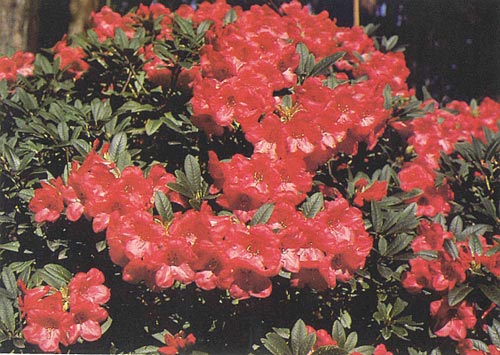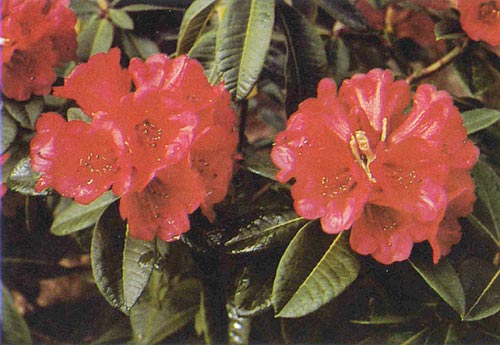QBARS - v34n4 R. 'Elizabeth'
R. 'ELIZABETH'
Arthur W. Headlam, Bentleigh, Australia

|
|
R. 'Elizabeth'
Photo by Arthur Headlam |
Rhododendron 'Elizabeth' ( R. forrestii var. repens x R. griersonianum ), received the Award of Merit in 1939. It does not appear to have inherited the somewhat difficult constitution of R. forrestii var. repens , of which there appear to be extremely few plants in cultivation in Australia, nor the slight cold tenderness of R. griersonianum . An indication of its popularity is that it was awarded the F. C. C. in 1963 and the A. G. M. in 1966.
I was interested to read the notes by R. L. Ticknor on Fall Flowering Rhododendrons in the Portland Chapter Rhododendron News, Vol. XIII No. 1 of February 1980, on some cultivars such as 'Elizabeth'. 'Purple Splendour' and others, which produce a number of out-of-season blooms each fall.
'Elizabeth' and the cultivars 'Max Sye' and 'Purple Splendour', which are widely grown at Olinda in the Dandenong Ranges, alt. 2,000 feet, are prone to this unfortunate habit in late fall and early winter, which somewhat spoils the truss when it eventually opens in the main flowering season, however, it appears to be confined mainly to young vigorously growing plants, and as they reach maturity this habit almost disappears. I use the word almost, for in some years the out-of-season blooms recur to what may be described as a minor degree. These blooms seem to appear after early autumn rains followed by sunny days in the late fall and early winter, which apparently deludes the rhododendrons into thinking that spring has arrived some months ahead of its normal time, but winter still lies ahead!

|
|
R. 'Elizabeth' x
R. arboreum
Photo by Arthur Headlam |
The group of 'Elizabeth' was photographed in the National Rhododendron Garden at Olinda in mid-spring and leaves one in no doubt as to its beauty and quality when it flowers normally.
One of our leading hybridizers, Karel Van de Ven, has very successfully overcome the habit of 'Elizabeth' producing odd flowers throughout the late fall and early winter by crossing it with R. arboreum , but the character and form of 'Elizabeth' has lost to what is another red R. arboreum hybrid, even though an attractive one.
'Elizabeth', and in fact, most R. griersonianum hybrids are almost impossible to grow successfully in Melbourne, where summer temperatures exceed 100° F., on generally six or seven occasions each year.
As a matter of interest, Indica and Kurume azaleas in Melbourne and the Dandenongs produce a flush of flowers in the fall each year, admittedly not as extensive as the main flowering season in the spring, nevertheless quite sufficient to make a regular and colorful out-of-season display each year.
